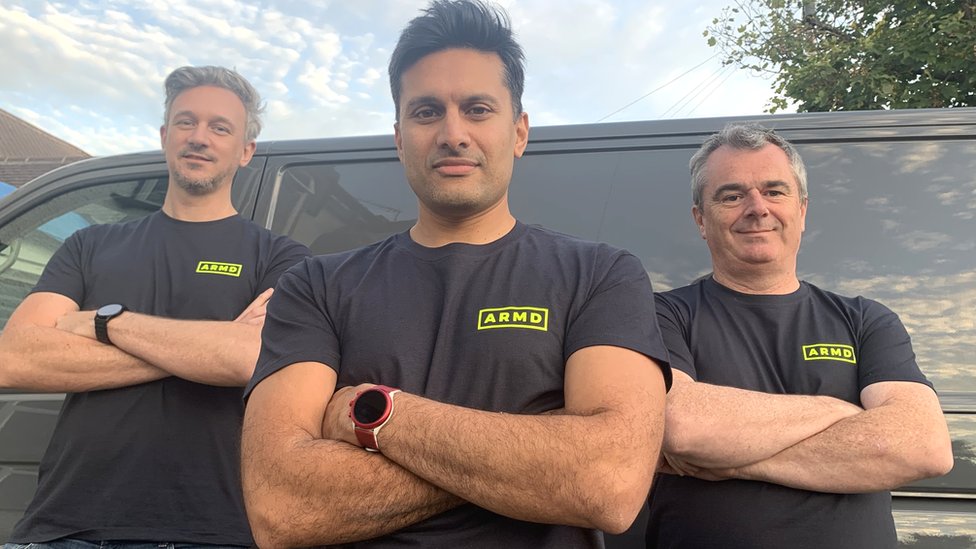[ad_1]
“How High-Tech Security Systems Are Fighting Against a Wave of Tool Theft”
Stolen tools cause stress and disruption for a handyman
It was his van alarm that woke him up. At 2:30 in the morning.
As carpenter Derek (not his real name), who lives in the Midlands, ran down the steps and out into his front yard, he heard the thieves flee into the night.
Derek says his tools have been stolen more than a dozen times in his career.
Once, criminals struck in broad daylight when he was unloading his van at work.
“They actually told me that if I called the police, they would come back and kill my family,” he recalls.
“Then you don’t sleep for the next few days, you’re panicking that they’ll come back.”
The late-night burglary last fall seemed like the last straw. When Derek added up the value of the stolen tools – he estimates them to be worth £7,000 – desperation erupted.
Was it even worth going on as a carpenter, the job he’d had since he left school? “I was ready to take it,” he says.
Every few minutes, tools are stolen somewhere in the UK
Tool theft is a shockingly common crime. According to insurer Direct Line, a tradesman’s tool is stolen every 17 minutes in England, Wales and Northern Ireland.
Those affected say it is much more than an inconvenience. Insurance claims can be complicated and don’t always cover the costs. You could lose days or even weeks of trading while sourcing a replacement kit. And it can affect your mental health.
But there are technologies designed to prevent tool theft, or at least reduce the hassle should it happen.
A few years ago, when Devin Chawda and Stephen Holland demonstrated a security camera they had developed at a trade show, builders and electricians kept asking them if they could install the camera in their vans.
For this reason, they founded ARMD, a company specializing in technology and insurance against tool theft.
“If someone breaks in, you’re alerted immediately, you can take action, you can record, you can alert the police,” says Mr. Chawda via Zoom, while his co-founder, Mr. Holland, holds up the small motion sensor and location tracker for commercial vehicles.
There is a separate hub with a SIM card that can be hidden in the front of the van. It connects the system to a cellular network. If someone unplugs the hub, it will trigger an automated call notifying the owner.
AMRD founders (left to right) Stephen Holland, Devin Chawda and Duncan Jackson
Still, technology isn’t necessarily enough, suggests Mr. Holland.
“Getting them back to work became our mission,” he says, explaining how ARMD launched an insurance product specifically for tradespeople in late 2021.
The coverage is linked to a special smartphone app.
It is a digital inventory of every valuable piece of equipment a plumber or contractor might have and shows the insured value of each tool. For a new tool, that number starts at 100% of retail value and decreases by 10% every year to at least 50%, says Mr. Chawda.
Crucially, ARMD aims to pay out genuine claims as quickly as possible. The company has so far registered around 80 customers and settled a total of 7 claims. The longest of which lasted only three days.
There are alternative technologies that are designed to help combat the effects of tool theft.
For example, a tool inventory app available for smartphones called The Tool Register was featured in a research briefing on tool theft published by the House of Commons Library last year.
A spokesman for uWatch, the app’s maker, says it has around 500 users. uWatch also offers a security device called The Cube, which is equipped with a camera and motion and location sensors, among other things.
“There are members who literally put cages in their vehicles,” says Darren Crannis, technical director of the Electrical Contractors’ Association (ECA), which represents 3,000 member companies with a total of 27,000 individual contractors.
Some even choose to put fake logos on their vans to disguise they are in a construction trade and hide the fact that there may be tools in the vehicle, he says.
Craftsmen can also install hidden cameras in vans, apply forensic marking products like microdots to their tools, and mark them as protected, for example. And there’s a range of robust locks, safes and alarm systems to keep equipment secure, whether it’s stored in a van or a shed, for example.
“Have you seen the latest James Bond where only he can hold his gun and it works?” says Mr. Crannis. “That would be really awesome.”
Milwaukee markets trackers that attach to tools
Some real-world technologies actually come close. For example, tool brand Milwaukee launched a system called One-Key in 2016. It uses sensors attached to or built into tools that connect to a handyman’s smartphone via Bluetooth. You can set up a geofence, a specific area on a map, so that a warning is displayed when a tool is used outside of that area.
From there you can track the tools, but only when they come within range of a phone with the app installed.
According to Milwaukee, it has around 400,000 users across Europe whose smartphones offer a kind of patchwork of detectors scattered across the continent.
It’s also possible to disable some Milwaukee tools remotely, meaning they won’t work until they’re restored and re-enabled. The company also develops versions of its locators for swappable tool batteries, as large batteries can sometimes cost hundreds of pounds.
“Once the technology is in place, we need to start using it,” says Andy Hartley, key account manager at contractor GCL and ECA’s South East Region Chair. He recalls working on a construction site in London where he estimates tools have been stolen repeatedly – between 10 and 15 times.
But how far will all of this help if demand for stolen tools remains high? “This indicates a widespread market within the construction industry. Where will these tools go?” says Brian Berry, executive director of the Federation of Master Builders.
He suggests that licensing or tighter regulation of construction companies could help.
More technology of business:
Craftsmen speaking to the BBC pointed out that tool theft was often reported to the police, but that prosecutions or successful recovery of stolen tools were extremely rare.
A spokesman for the National Council of Police Chiefs said: “Tool theft cases are complicated due to limited forensic capabilities. We will continue to work hard to prevent tool theft and encourage victims to report these cases to the police.”
In Derek’s case, he immediately reported last year’s burglary. Since then, however, he has heard nothing.
The incident was almost enough to end his carpentry business, but friends encouraged him to keep going.
However, he has not yet been able to cover the cost of replacing all the tools stolen during the last burglary.
“It’s like starting from scratch,” he says.
[ad_2]
Don’t miss interesting posts on Famousbio










